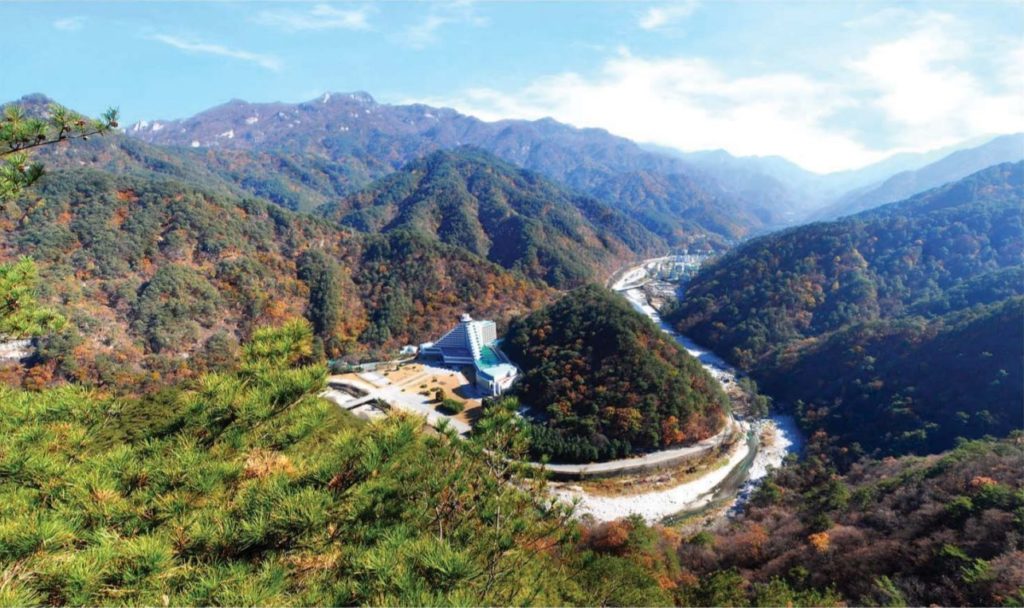Introduction
Mt. Myohyang (‘Mysterious Fragrant Mountain’) is one of North Korea’s five celebrated mountains and is located 150km northeast of Pyongyang in North Pyongyan Province. Piro Peak is the highest point at 1909m, making Mt. Myohyang the third highest mountain in North Korea.
Popular as a vacation hotspot, the Mt. Myohyang range stretches 128km and is weaved with hiking trails and dotted by preserved ancient remains dating back to the 7th century. Legend says that King Tangun, widely regarded as the founding father of the Korean nation, called these mountains his home.

What's the landscape like at Mt. Myohyang?
The landscape of Mt. Myohyang is comprised of spectacular woodland scenery, with waterfalls flowing over white granite outcrops, relaxing clear streams and a unique ecosystem of plants and animals which has earned its place as a World Biosphere Reserve by UNESCO. Within the sunken valleys, you’ll find peaceful hermitages with practicing Buddhists, and ancient pavilions that have become favourite spots for an impromptu picnic. Mt. Myohyang is particularly beautiful in autumn, where the dense pine forest is brushed with reds, yellows and oranges.
How do you get to Mt. Myohyang?
By Road: Mt. Myohyang is connected directly to Pyongyang by multi-lane road, the Pyongyang-Hyangsan Motorway. The 150km journey typically takes 2.5 hours. This proximity to Pyongyang makes Mt. Myohyang the most accessible nature reserve for travellers with limited time. On the drive to Mt. Myohyang, it’s possible to detour through Pyongsong city which is an important science and cultural hub. Anju city is also visitable but there is very little to draw tourists. Roughly halfway along the Pyongyang-Hyangsan Motorway there is a rest stop to buy snacks or have a coffee.
By Train: Mt. Myohyang is also connected by railway between Pyongyang Station and Myohyangsan Station in Hyangsan town. However, to take this option, the train must be privately chartered.
By Helicopter: For those looking for something truly special, we can charter a Soviet-era Mil Mi-17 helicopter to reach Mt. Myohyang from Pyongyang. There is a helipad just outside Hyangsan town.
What's the weather like in Mt. Myohyang?
Enclosed by towering peaks, the Mt. Myohyang area is protected from strong winds and remains relatively warm. The annual average temperature is 8 degrees Celsius, with temperatures ranging from below zero in January to 24 degrees Celsius in August. Annual precipitation is 1300mm of which 60% falls in July and August. The heat and rainfall of these months make hiking challenging, but the waterfalls will be at maximum capacity and after the rain settles and mist envelopes the valleys you’ll see how Mt. Myohyang got its name!
How do I include Mt. Myohyang in my itinerary?
Due to its proximity to Pyongyang, there are flexible options to visiting Mt. Myohyang and the length will depend on your interests and desire for hiking.
Day trip: Day trips to Mt. Myohyang from Pyongyang are possible but you can expect an early start, a late return and an overall exhausting day. The drive is 2.5 hours each way. We don’t recommend this option unless you’re extremely limited with time.
Overnight trip: This is the typical way to visit Mt. Myohyang and comes highly recommended. You’ll make efficient use of your time, stay overnight in Mt. Myohyang, and have breathing space for activities. Hiking can be arranged either the afternoon of arrival or left until the day after.
Multi-night trip: This option is recommended if you’re planning to undertake at least two hikes in Mt. Myohyang. Without a focus on longer or multiple hikes, there’s no need to stay more than one night in Mt. Myohyang, one night is enough time to include the highlights.
TIPS FOR VISITING MT. MYOHYANG
- Bring a warm jacket for the visits to the International Friendship Exhibition and Ryongmun Cavern, which can get cold inside.
- Bring comfortable shoes for hiking. If hiking in summer, bring a rain jacket and a waterproof bag to place valuables (camera) if caught in a rain shower.
- Plan for a picnic in nature rather than eating back at the hotel
- The International Friendship Exhibition and Pohyon Temple are best visited in the morning, with hiking after lunch.
